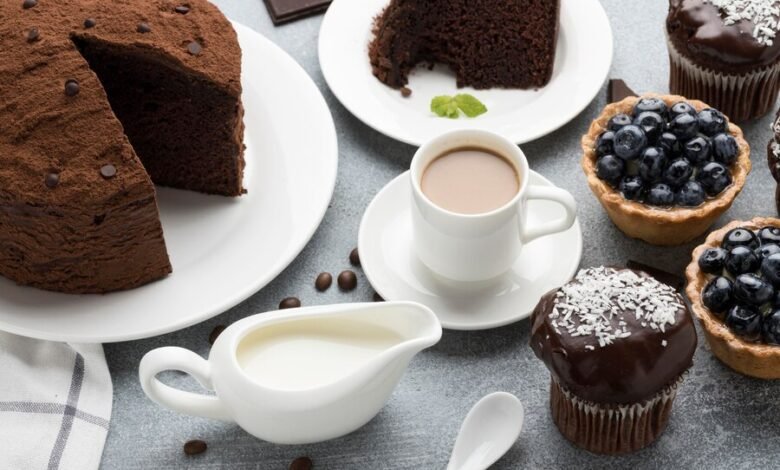
Coffee pairs well with sweetened coffee cake. The traditional breakfast or informal gathering dish is made with moist ingredients and crumbly toppings. Coffee cakes, in contrast to more conventional cakes, are best served without frosting to preserve their texture and taste. So order a coffee cake to make your celebration more memorable.
But the decadent taste of chocolate cake comes from cocoa powder or melted chocolate. One of the reasons why this cake is always a hit at celebrations is because of the chocolate icing.
Cultural Significance of Each Cake
The baking traditions of the two cakes are quite different. Coffee cake is more appropriate for chilly mornings and casual get-togethers, whereas chocolate cake is reserved for special occasions and holidays. When combined, they make a delicious baking mix that everyone may enjoy.
Ingredients that Make Each Cake Unique
Core Ingredients in Coffee Cake
Flour Varieties and Their Roles
For the ideal combination of cake softness and cake firmness, use all-purpose flour while making coffee cake. A gluten-free alternative that yields a nuttier flavour is whole wheat flour.
Common Additions: Nuts, Fruits, and Spice
Onions, cinnamon, nutmeg, apples, blueberries, and crumbled nuts are common components of coffee cakes. A basic cake’s taste and texture are elevated with the addition of these components.
The Purpose of a Crumb Topping
Coffee cake’s basic crumble topping is made with cinnamon, sugar, butter, and flour. The crumbly topping complements the rich cake well.
Core Ingredients in Chocolate Cake
Cocoa vs. Chocolate: What’s the Difference?
Alternatively, you may use melted chocolate for a richer cake or cocoa powder for a softer one. The flavor is affected by the decision since cocoa has a milder chocolate flavor than melted chocolate.
Sweeteners Used in Chocolate Cake
Honey or maple syrup, rather of brown sugar or granulated sugar, is an alternative in certain unusual chocolate cake recipes. Sugars have different effects on taste and moisture.
Flavor Enhancers: Vanillas and Extracts
Vanilla essence enhances the flavor of chocolate cake. Choco may need some unexpected flavors, like orange or almond, to really shine.
Special Dietary Variations
Gluten-Free Options for Both Types
Chocolate and coffee cakes may be made gluten-free by using almond flour, coconut flour, or store-bought gluten-free flour mixtures.
Vegan Adaptations
These cakes may be made vegan by replacing the dairy and eggs with almond milk, applesauce, or flaxseed meal.
Low-Sugar Versions
Two delicious natural sweeteners and stevia, can produce sugar-free chocolate desserts and coffee.
Techniques for Baking the Perfect Cake
Baking Methods for Coffee Cake
Mixing Techniques: The Two-Bowl Method
Two dishes are used for traditional coffee cake mixing. Combine items that are wet in one bowl. Combine the dry components in a separate bowl. Flavors are distributed evenly when this is done.
Importance of Layering Flavors
Baking with alternating fruit, spice, and nut additions creates a complex taste profile. Using this method, a single slice might contain many flavors.
Baking Times and Temperature Considerations
Baking coffee cakes for an extended period of time at 350°F is the norm. Be careful not to overbake them because of the wet crumb.
Baking Methods for Chocolate Cake
The One-Bowl Method for Simplicity
A lot of people like chocolate cake that just requires one dish. If you want your batter to be well-integrated and your cleanup to be minimal, use just one bowl to mix all of the ingredients.
Frosting Techniques: When and How to Apply
Spread frosting on a cooled chocolate cake. The frosting is made smoother and nicer by sealing in crumbs with a crumb coat.
Creating a Rich Texture: Tips for Moistness
To moisten the batter, you may use buttermilk or coffee. Use these to moisten the cake and give it flavor.
Oven Considerations
Convection vs. traditional Baking
Convection ovens are perfect for both types of cakes because they evenly heat them. Modifications to the baking time may be necessary for a conventional oven.
Using the Right Baking Pans
What makes a cake unique is the bread pan. Browning food in dark pans takes less time than in glass pans.
Cooling and Storage Techniques Post-Baking
After a short time in the pan, transfer the cakes to wire racks to cool completely. To maintain their freshness, store them in a container that seals tightly or wrap them in plastic.
Flavor Profiles: What Sets Them Apart?
The Sweet and Spicy Notes of Coffee Cake
Flavor Depth from Spices Like Cinnamon and Nutmeg
The warm spices, such as cinnamon and nutmeg, give coffee cake its signature aroma and texture.
Balancing Sweetness with Tartness in Fruit Additions
You can balance out the sweetness with tangy fruits, such as berries or citrus.
How Toppings Influence Flavor
Coffee with a crumb topping is more Tasty
Varieties of Chocolate and Their Flavors
Bitter dark, semi-sweet, or milk chocolate can evoke a wide range of emotions.
The Role of Acid and Sugar
The bittersweet chocolate flavor complements the cake’s sugary texture.
Using Coffee to Enhance Chocolate Flavor
Because the coffee in the batter brings out the coffee’s full flavor, this cake is a hit with chocolate lovers.
Conclusion
Baking mastery is on display when one mixes the storied pasts and mouth-watering tastes of two classic cakes—coffee cake and chocolate cake. Whether you prefer a luscious chocolate cake or a light coffee cake, we guarantee you’ll discover a flavorful option. Get out your baking ingredients; your taste buds will be for all time.



